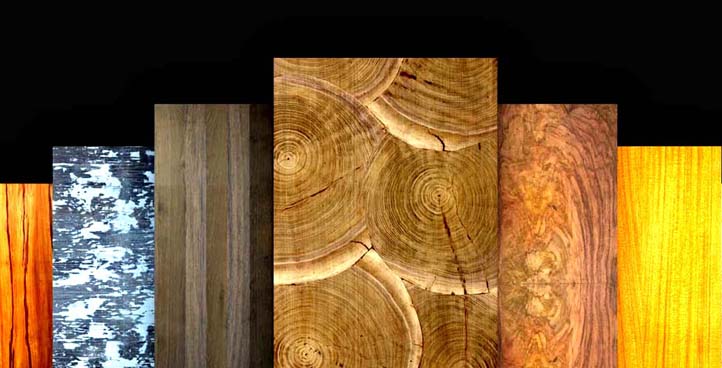
Veneer
About
Veneers are a thin sheet of a material: such as. a : a layer of wood of superior value or excellent grain to be glued to an inferior wood. b : any of the thin layers bonded together to form plywood. c : a plastic or porcelain coating bonded to the surface of a cosmetically imperfect tooth.
Producing Wood Veneers
The finest and rarest logs are sent to companies that produce veneer. The advantage to this practice is twofold. First, it provides the most financial gain to the owner of the log. Secondly, and of more importance to the woodworker, it greatly expands the amount of usable wood. While a log used for solid lumber is cut into thick pieces, usually no thinner than 1/8 of an inch (3 mm), veneers are cut as thin as 1/40 of an inch (0.6 mm). Depending on the cutting process used by the veneer manufacturer, very little wood is wasted by the saw blade thickness, known as the saw kerf. Accordingly, the yield of a rare grain pattern or wood type is greatly increased, in turn placing less stress on the resource. Some manufacturers even use a very wide knife to “slice off” the thin veneer pieces. In this way, none of the wood is wasted. The slices of veneer are always kept in the order in which they are cut from the log and are often sold this way.
Types of Veneers
Raw Veneer has no backing on it and can be used with either side facing up. It is important to note that the two sides will appear different when a finish has been applied, due to the cell structure of the wood.
Paper Backed Veneer is as the name suggests, veneers that are backed with paper. The advantage to this is it is available in large sizes, or sheets, as smaller pieces are joined together prior to adding the backing. This is helpful for users that do not wish to join smaller pieces of raw veneers together. This is also helpful when veneering curves and columns as the veneer is less likely to crack.
Phenolic backed Veneer is less common and is used for composite, or artificial wood veneers. Due to concern for the natural resource, this is becoming more popular. It too has the advantage of being available in sheets, and is also less likely to crack when being used on curves.
Laid Up Veneer is raw veneer that has been joined together to make larger pieces. The process is time-consuming and requires great care, but is not difficult and requires no expensive tools or machinery. Veneers can be ordered through some companies already laid up to any size, shape or design.
Reconstituted Veneer is made from fast-growing tropical species. Raw veneer is cut from a log, and dyed if necessary. Once dyed, the sheets are laminated together to form a block. The block is then sliced so that the edges of the laminated veneer become the “grain” of the reconstituted veneer.
Wood on Wood,Also called 2-ply is a decorative wood veneer face with a utility grade wood backer applied at an opposing direction to the face veneer
Our Services
We provides various products made of Wood Veneers
